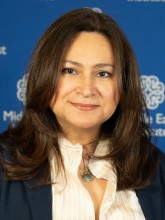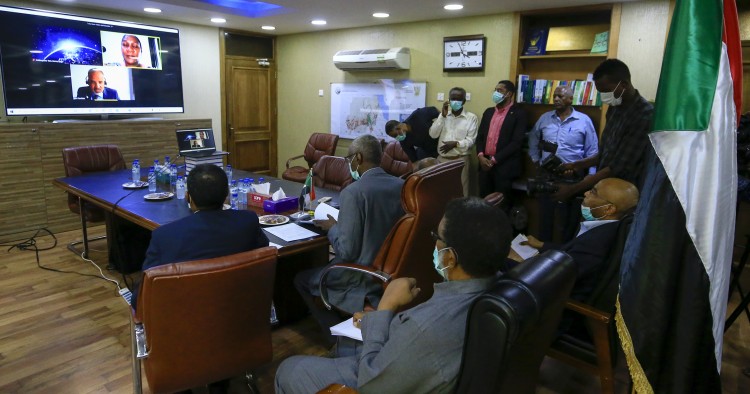This week's briefing on recent news and upcoming events in the region featuring Mirette F. Mabrouk, Marvin G. Weinbaum, Gonul Tol, Alex Vatanka, and Gerald Feierstein.
GERD talks continue, but political will is still lacking
Mirette F. Mabrouk
Senior Fellow, Director of Egypt program

It’s never a good sign when negotiators differ on the desired outcomes of negotiations.
Last week, hours after an African Union (AU) sponsored summit on the filling and operations of the Grand Ethiopian Renaissance Dam (GERD), Ethiopia’s Water, Irrigation, and Energy Minister Seleshi Bekele had to walk back reports by a state-owned broadcaster suggesting the government had formally authorized the reservoir to be filled. Egypt and Sudan had asked that the filling not commence until an agreement on the filling and operation of the dam was in place. The media was flooded with satellite images of water pooling in the reservoir behind the dam, prompting calls for clarification from both Egypt and Sudan. Bekele insisted that it was merely due to the heavy rains.
It's an entirely reasonable assumption, at this stage of the dam’s construction and with the current heavy rainfall, but a more pertinent question would be whether the sluice gates were then closed or not. In any event, Ethiopian Prime Minister Abiy Ahmed effectively put paid to the questions in a statement saying that the “current rainfall and runoff situation in the region had made it conducive to fill the dam.”
The AU sponsored talks fizzled to an end without any tangible results. The only good takeaway, such as it was, appeared to be a clear attempt to defuse rising tensions, in the form of flowery, if ultimately useless, statements. In his official Twitter account, Ethiopian PM Ahmed described the meetings as “fruitful” and said that a “great understanding” had been reached, thanking his “brothers” Egyptian President Abdel-Fattah el-Sisi and Sudanese Prime Minister Abdalla Hamdok for "the common understanding reached to continue the technical discussions on the filling."
The official Ethiopian statement that followed said that the country was “committed to a balanced and mutually beneficial negotiation.” AU Commission Chairman Moussa Faki Mahamat also tweeted that he considered it "absolutely necessary" that "an agreement be reached that preserves the interest of all parties."
The Egyptian statement was similarly flowery but referred to the negotiations’ desired outcome as being a binding legal agreement on the GERD’s filling and operation.
A few days later, the AU issued a statement on behalf of its chairman, South African President Cyril Ramaphosa, which said that Egypt, Sudan, and Ethiopia had welcomed its expert report on the issues and that the respective heads had “agreed on the process of finalizing negotiations on the text of a binding agreement on the filling and operation of GERD, which include a comprehensive agreement on future development on the Blue Nile river.”
Ethiopia’s response must have caught the AU rather by surprise. Their Foreign Ministry Spokesperson Dina Mufti told an Emirati newspaper that “The Ethiopian government does not look for a binding agreement concerning the current talks about GERD, only a guidelines agreement which can be revised at any time.”
While the GERD has been a contentious project since it was first announced in 2011, this issue is at the core of the dispute between Egypt, Ethiopia, and Sudan.
With a reservoir capacity of 74 billion cubic meters (bcm), the GERD will be the seventh-largest hydropower dam in the world and the largest in the region. Domestically funded, the dam is a huge source of national pride for its people, who are looking to it to help boost their economy. Dams can also provide benefits to downstream countries by regulating floods, which would be especially beneficial to Sudan. Under normal circumstances the dam wouldn’t pose much of a threat to the downstream countries, Egypt and Sudan, although there is no way of knowing for sure since the GERD is the only dam of its kind to have been built without an Environmental and Social Impact Assessment (ESIA).
What Egypt and Sudan are worried about is the filling and operation of the dam during water shortages or droughts. Sudan is 50 percent desert and Egypt 96 percent desert. Egypt is already one of the most water poor countries in the world, with an annual per capita share of 560 cubic meters — well below the internationally recognized norms for water scarcity, which are set at 1000 cubic meters annually per capita. The country relies on the Nile for over 90 percent of its fresh water and, contrary to popular belief, has never found the vast reserves of underground water that were once hoped for a decade ago. Ethiopia, by contrast, is water rich, with over 936 bcm in annual rainfall alone. The issues, though, have never been about water or the technical aspects — all three countries have quite enough technical expertise to sort out any issues.
The dam has long been surrounded by rumor and misinformation with nationalist chest thumping among citizens of all three countries (the states themselves have maintained the line that diplomatic negotiation is the way forward). Coverage of the dam often refers to Egypt and Sudan attempting to hold Ethiopia to “colonial era agreements” in reference to agreements between the two countries in 1929 and 1959 that largely split Nile Basin reserves between them and that Ethiopia was neither party to, nor recognized. In actual fact, during the decade of negotiations, Egypt refers only to the three agreements signed with Ethiopia: the 1902 agreement signed with Emperor Mennalik II, the 1993 agreement signed by Prime Minister Meles Zenawi and President Hosni Mubarak, and the 2015 Declaration of Principles signed by Prime Minister Hailemariam Desalegn, Prime Minister Hamdok, and President Sisi. Additionally, Egypt and Sudan note the harmful effects of similar Ethiopian projects on Djibouti, Kenya, and Somalia in their insistence on a binding dispute mechanism. Matters are further complicated by the fraught political situation in Ethiopia; in a politically divisive and charged landscape, the dam is a national unifier and it is not in Ahmed’s interest to be seen as offering concessions.
All negotiations must have a common desired outcome to be successful and it is unlikely that the AU negotiations, like the U.S.-sponsored talks before them, will bear fruit. To date, Ethiopia clearly does not believe it is in its interest to cooperate with Egypt and Sudan rather than go it alone, and neither country has much leverage. Nor, despite Egypt’s efforts to involve the international community, is it likely that international players will get involved. The onus will remain on Egypt and Sudan to persuade Ethiopia that the full benefits of the dam may be realized with cooperation, rather than unilateral actions. Access to Egypt’s power grid, for example, would allow Ethiopia to sell electricity to Asia and Europe via Cyprus. There is still time, and plenty of technical solutions, to come to a mutually beneficial outcome. What’s lacking is the political will.
Afghanistan’s war within a war
Marvin G. Weinbaum
Director for Afghanistan and Pakistan Studies

As the conflict between Afghan forces and the Taliban rages on, another battle is being fought in Kabul. It pits the camp of President Ashraf Ghani against that of his veteran adversary Abdullah Abdullah. The casualties of this conflict are not figured in human lives but in the ways the Afghan state has been disabled. After the disputed September 2019 presidential election, the opposition had stubbornly refused to accept the validity of the Ghani regime and sought opportunities to bring down the government. It was with great relief, then, that the two leaders, seeming to put aside their differences for the good of the country, signed a power-sharing arrangement on May 17. Cabinet positions would be divided, and Abdullah had settled for taking leadership of the government’s peace delegation for negotiating with the Taliban.
But now, more than two months later, a new government is still waiting to be formed. The May agreement has done little to settle the underlying differences among political interests or overcome the deep personal animosities that divide the country’s political elites. The extensive delay has exposed the fractures both within an insecure Ghani government and the opposition’s fragile coalition. The present impasse centers on naming cabinet members, although appointments to governorships and diplomatic assignment are also being fought over. Last week Abdullah presented a list of 12 nominees, only to have five of the choices for key ministerial position rejected by the president’s office for lack of merit. Oddly, very recently, Ghani approved giving the country’s highest military honor, that of marshal, to Abdul Rashid Dostum, widely acknowledged to be among the most rapacious of the country’s warlords and charged not long ago by the government with the sexual assault of a political rival. Although Ghani initially hesitated to award the title to Dostum, the president in his search for political allies found it difficult to alienate the regionally powerful, maverick Uzbek leader, once one of his former vice presidents.
With intra-Afghan talks on the horizon and American troops on their way out, Afghanistan’s accustomed political infighting is an unaffordable luxury. A badly disunited political elite severely weakens the government’s hand when it needs all the leverage it can muster for negotiations with the Taliban. While the Taliban, for all its own internal rivalries, has readied a unified delegation for prospective meetings in Doha, the designated members on the government side represent a diverse body expected to focus on promoting their separate interests. The Afghanistan political system is already under attack for discrimination, corruption, and injustice. To have the spectacle of a political class at war with itself is to risk forfeiting what is left of the trust and loyalty of the Afghan people.
This article was co-authored by Hamid Safi and Sawera Khan, research assistants to Marvin G. Weinbaum.
Despite rise in femicides, Erdogan faces pressure to withdraw from the Istanbul Convention
Gonul Tol
Director of Turkey Program and Senior Fellow, Frontier Europe Initiative

The murder of a 27-year-old woman by an ex-boyfriend has sparked outrage in Turkey. The remains of Pinar Gultekin, a student in the Aegean province of Mugla, were discovered in a garbage bin covered with concrete. Reportedly, the ex-boyfriend first strangled her before later burning her body. The murder is one of over 100 femicides recorded in Turkey so far this year. There has been a dramatic increase in the country’s femicide rate in the last few years. Despite this, the government is now debating whether to roll back legislation designed to combat gender-based violence against women. Turkey adopted the 2011 Council of Europe convention on gender-based violence and domestic violence, known as the Istanbul Convention, which aims to prevent violence against women and prosecute offenders. If implemented, rights groups argue, the Convention could significantly decrease violence against women. But Turkish President Recep Tayyip Erdogan has come under increasing pressure to withdraw from the agreement. Religious orders, prominent Islamist intellectuals, and cult leaders are arguing that it threatens traditional family values, encourages homosexuality, and discourages “honor killings,” which they think are crucial in sustaining society.
Erdogan is in a difficult spot. His alliance with the far-right Nationalist Action Party (MHP) has not secured him a comfortable majority. Public opinion polls indicate that support for the Justice and Development Party (AKP) and the MHP is well below the 50 percent necessary to win the 2023 elections. Thus, every vote counts, making even marginal Islamist groups critical for Erdogan’s electoral fortunes. AKP Deputy Chair Numan Kurtulmus’s statement that the Istanbul Convention was “very wrong” signals Islamists might get their way. But Erdogan’s bigger partner, the MHP, is not on board, and the party’s leader, Devlet Bahceli, recently hinted at his displeasure with plans to withdraw from the Convention. Erdogan has to get creative to balance the conflicting demands within his ruling bloc. The fact that he faces fresh challenges from newly established center-right parties after having dominated the country’s center-right for so long underlines just how difficult that task is going to be.
Tehran’s pushback against US interception of Iranian passenger plane is about more than PR
Alex Vatanka
Director of Iran Program and Senior Fellow, Frontier Europe Initiative

Tehran is deeply troubled by the July 23 interception of an Iranian civilian airliner over Syria by two U.S. F-15 fighter jets. What has captured the Western media’s attention is Iran’s charge that the U.S. is essentially carrying out acts of “piracy” and “terrorism” in the skies above Syria. This part of Tehran’s charges is entirely predictable. It is just the latest episode in the long-running cycle of accusations and counter-accusations between the U.S. and Iran. Tehran will want to keep this event alive as long as possible. It fits nicely with its ideological messaging that the U.S. military, as an extra-regional power, is a destabilizing force in the Middle East. “The Iranian foreign ministry, Iran Civil Aviation Organization, judiciary system, and the General Staff of the Armed Forces of the Islamic Republic of Iran will take the necessary measures to make the U.S. regret what it has done,” Tehran has already announced.
Scoring public relations points is not all Tehran wants to extract from the July 23 incident, however. The Iranian authorities are also aiming to leverage this episode as a way to put pressure on countries in the region that provide basing rights to the U.S. military. In this case, Tehran has Jordan in its sights. Iranian media reports suggest the two U.S. F-15 jets had taken off from the Muwaffaq Salti Air Base in central Jordan. This is a base the U.S. has long used for its missions in Iraq and in the campaign against ISIS in Syria since 2013. The base is reportedly under a major expansion as part of a $140 million upgrade. The airbase is also said by Tehran to be home to a fleet of armed drones, including those used in the January 2020 assassination of Gen. Qassem Soleimani in Baghdad. At the time, the Iranians did not point the finger at the Jordanians. This time around, however, Tehran is specifically warning King Abdullah of Jordan to be ready to accept the consequences of being complicit in American actions against Iran, including in the killing of Soleimani. The Iranians know well that U.S.-Jordanian military-to-military ties are very close. The aim is not to squeeze the Jordanians to rethink their relations with the Americans, but rather to push them, and other regional hosts to the U.S. military, to impose limitations on what U.S. operations originating from bases in those countries can and cannot do vis-à-vis Iran. This Iranian focus on Jordan also comes at a time where the future size of the U.S. military’s presence in Iraq is under considerable doubt, and Jordan could end up as the main staging ground for the U.S. military in the region.
Sheikh Sabah, King Salman: Recent health woes underscore a regional leadership in transition
Gerald Feierstein
Senior Vice President

Recent hospitalizations of Saudi Arabia’s 84-year-old ruler, King Salman, and Kuwait’s 91-year-old ruler, Sheikh Sabah, have underscored that the process of transitioning to a new line-up of leaders in the states of the Arabian Peninsula continues. Following surgery in Kuwait, Sheikh Sabah is being moved to the U.S. for further treatment of his unspecified illness. King Salman reportedly underwent gallbladder surgery in Riyadh, although his post-surgery appearance on television calmed concerns about the overall state of his health.
The long-anticipated transition from the Gulf states’ geriatric leadership commenced early in 2020 with the passing of Oman’s ruler of nearly a half-century, Sultan Qaboos. The transition in the region is not entirely a youth movement, however. Sultan Qaboos’ successor, Sultan Haitham, is in his mid-60s. The Kuwaiti crown prince, Sheikh Nawaf al-Ahmad al-Sabah, is the 83-year-old half-brother of Sheikh Sabah.
But a new generation of leaders is waiting in the wings to take over. Saudi Crown Prince Mohammed bin Salman in his 30s, Qatari Amir Tamim bin Hamad in his 40s, and Abu Dhabi Crown Prince Mohammed bin Zayed in his late 50s are likely to dominate the Gulf for decades to come. While each of the three is unique and faces unique challenges, there are similarities in their leadership that offer clues about the direction they will likely pursue: 1) a more aggressive push for regional and global leadership; 2) fundamental economic reforms to diversify away from dependence on the export of fossil fuels; and 3) a more nationalistic approach to politics and society. From the UAE’s space program to Qatar’s World Cup and its national museum and Saudi Arabia’s new-found embrace of its pre-Islamic heritage, each of the leaders seeks to wrap his legitimacy in initiatives that promote patriotism and an embrace of national identity and pride. How these three leaders interrelate, either in competition or cooperation, will set the stage for critical issues of regional security and stability for the foreseeable future.
Photo by ASHRAF SHAZLY/AFP via Getty Images
The Middle East Institute (MEI) is an independent, non-partisan, non-for-profit, educational organization. It does not engage in advocacy and its scholars’ opinions are their own. MEI welcomes financial donations, but retains sole editorial control over its work and its publications reflect only the authors’ views. For a listing of MEI donors, please click here.













